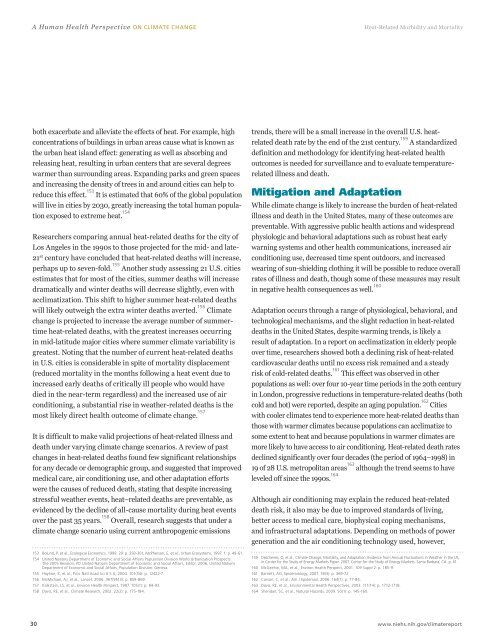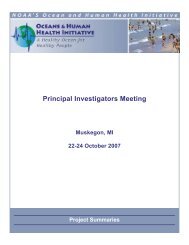A Human Health Perspective On Climate Change - The Oceans and ...
A Human Health Perspective On Climate Change - The Oceans and ...
A Human Health Perspective On Climate Change - The Oceans and ...
Create successful ePaper yourself
Turn your PDF publications into a flip-book with our unique Google optimized e-Paper software.
A <strong>Human</strong> <strong>Health</strong> <strong>Perspective</strong> ON CLIMATE CHANGEHeat-Related Morbidity <strong>and</strong> Mortalityboth exacerbate <strong>and</strong> alleviate the effects of heat. For example, highconcentrations of buildings in urban areas cause what is known asthe urban heat isl<strong>and</strong> effect: generating as well as absorbing <strong>and</strong>releasing heat, resulting in urban centers that are several degreeswarmer than surrounding areas. Exp<strong>and</strong>ing parks <strong>and</strong> green spaces<strong>and</strong> increasing the density of trees in <strong>and</strong> around cities can help toreduce this effect. 153 It is estimated that 60% of the global populationwill live in cities by 2030, greatly increasing the total human populationexposed to extreme heat. 154Researchers comparing annual heat-related deaths for the city ofLos Angeles in the 1990s to those projected for the mid- <strong>and</strong> late-21 st century have concluded that heat-related deaths will increase,perhaps up to seven-fold. 155 Another study assessing 21 U.S. citiesestimates that for most of the cities, summer deaths will increasedramatically <strong>and</strong> winter deaths will decrease slightly, even withacclimatization. This shift to higher summer heat-related deathswill likely outweigh the extra winter deaths averted. 156 <strong>Climate</strong>change is projected to increase the average number of summertimeheat-related deaths, with the greatest increases occurringin mid-latitude major cities where summer climate variability isgreatest. Noting that the number of current heat-related deathsin U.S. cities is considerable in spite of mortality displacement(reduced mortality in the months following a heat event due toincreased early deaths of critically ill people who would havedied in the near-term regardless) <strong>and</strong> the increased use of airconditioning, a substantial rise in weather-related deaths is themost likely direct health outcome of climate change. 157It is difficult to make valid projections of heat-related illness <strong>and</strong>death under varying climate change scenarios. A review of pastchanges in heat-related deaths found few significant relationshipsfor any decade or demographic group, <strong>and</strong> suggest ed that improvedmedical care, air conditioning use, <strong>and</strong> other adaptation effortswere the causes of reduced death, stating that despite increasingstressful weather events, heat–related deaths are preventable, asevidenced by the decline of all-cause mortality during heat eventsover the past 35 years. 158 Overall, research suggests that under aclimate change scenario using current anthropogenic emissions153 Bolund, P, et al., Ecological Economics, 1999. 29: p. 293-301, McPherson, E, et al., Urban Ecosystems, 1997. 1: p. 49-61.154 United Nations Department of Economic <strong>and</strong> Social Affairs Population Division World Urbanization Prospects:<strong>The</strong> 2005 Revision, PD United Nations Department of Economic <strong>and</strong> Social Affairs, Editor. 2006, United NationsDepartment of Economic <strong>and</strong> Social Affairs, Population Division: Geneva.155 Hayhoe, K, et al., Proc Natl Acad Sci U S A, 2004. 101(34): p. 12422-7.156 McMichael, AJ, et al., Lancet, 2006. 367(9513): p. 859-869.157 Kalkstein, LS, et al., Environ <strong>Health</strong> Perspect, 1997. 105(1): p. 84-93.158 Davis, RE, et al., <strong>Climate</strong> Research, 2002. 22(2): p. 175-184.trends, there will be a small increase in the overall U.S. heatrelateddeath rate by the end of the 21st century. 159 A st<strong>and</strong>ardizeddefinition <strong>and</strong> methodology for identifying heat-related healthoutcomes is needed for surveillance <strong>and</strong> to evaluate temperaturerelatedillness <strong>and</strong> death.Mitigation <strong>and</strong> AdaptationWhile climate change is likely to increase the burden of heat-relatedillness <strong>and</strong> death in the United States, many of these outcomes arepreventable. With aggressive public health actions <strong>and</strong> widespreadphysiologic <strong>and</strong> behavioral adaptations such as robust heat earlywarning systems <strong>and</strong> other health communications, increased airconditioning use, decreased time spent outdoors, <strong>and</strong> increasedwearing of sun-shielding clothing it will be possible to reduce overallrates of illness <strong>and</strong> death, though some of these measures may resultin negative health consequences as well. 160Adaptation occurs through a range of physiological, behavioral, <strong>and</strong>technological mechanisms, <strong>and</strong> the slight reduction in heat-relateddeaths in the United States, despite warming trends, is likely aresult of adaptation. In a report on acclimatization in elderly peopleover time, researchers showed both a declining risk of heat-relatedcardiovascular deaths until no excess risk remained <strong>and</strong> a steadyrisk of cold-related deaths. 161 This effect was observed in otherpopulations as well: over four 10-year time periods in the 20th centuryin London, progressive reductions in temperature-related deaths (bothcold <strong>and</strong> hot) were reported, despite an aging population. 162 Citieswith cooler climates tend to experience more heat-related deaths thanthose with warmer climates because populations can acclimatize tosome extent to heat <strong>and</strong> because populations in warmer climates aremore likely to have access to air conditioning. Heat-related death ratesdeclined significantly over four decades (the period of 1964–1998) in19 of 28 U.S. metropolitan areas 163 although the trend seems to haveleveled off since the 1990s. 164Although air conditioning may explain the reduced heat-relateddeath risk, it also may be due to improved st<strong>and</strong>ards of living,better access to medical care, biophysical coping mechanisms,<strong>and</strong> infrastructural adaptations. Depending on methods of powergeneration <strong>and</strong> the air conditioning technology used, however,159 Deschenes, O, et al., <strong>Climate</strong> <strong>Change</strong>, Mortality, <strong>and</strong> Adaptation: Evidence from Annual Fluctuations in Weather in the US,in Center for the Study of Energy Markets Paper. 2007, Center for the Study of Energy Markets: Santa Barbara, CA. p. 61.160 McGeehin, MA, et al., Environ <strong>Health</strong> Perspect, 2001. 109 Suppl 2: p. 185-9.161 Barnett, AG, Epidemiology, 2007. 18(3): p. 369-72.162 Carson, C, et al., Am J Epidemiol, 2006. 164(1): p. 77-84.163 Davis, RE, et al., Environmental <strong>Health</strong> <strong>Perspective</strong>s, 2003. 111(14): p. 1712-1718.164 Sheridan, SC, et al., Natural Hazards, 2009. 50(1): p. 145-160.30 www.niehs.nih.gov/climatereport










